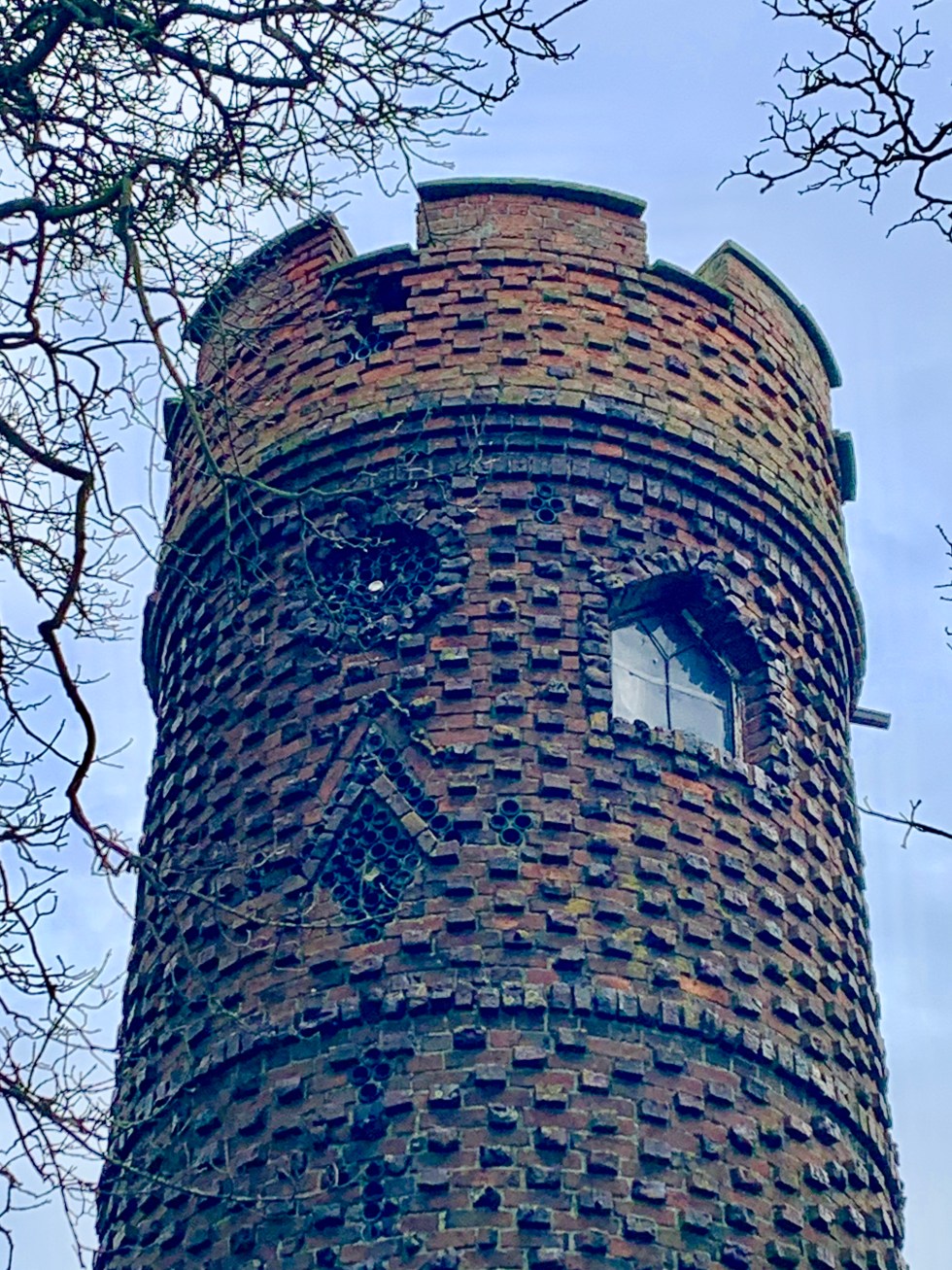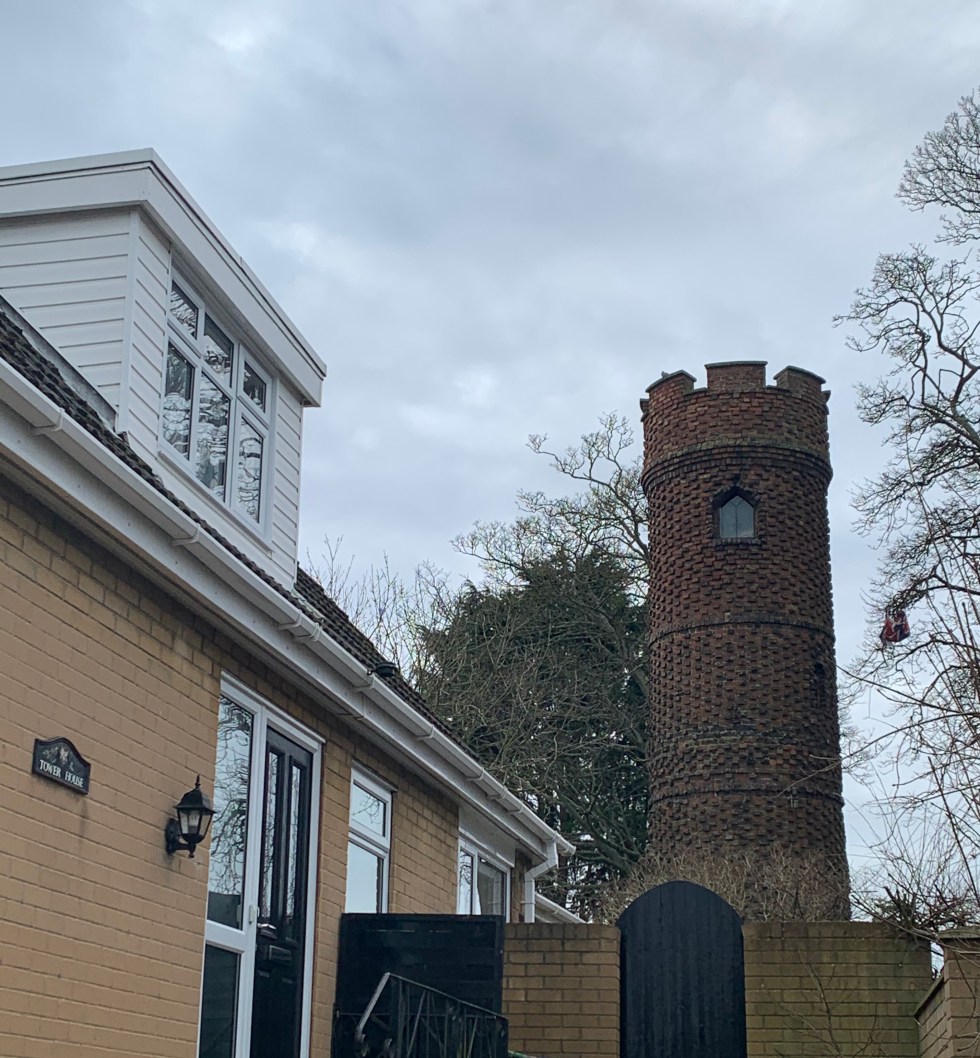In 1829 William Bettison Esq. purchased a country retreat on Newbegin in Hornsea, in the East Riding of Yorkshire. From here, he commuted by phaeton to Hull, where during his career he was owner of the Humber Street Brewery and proprietor of the Hull Advertiser. The house came with ‘extensive Pleasure Grounds’ and some time around 1844 he constructed this curious tower built of what are called treacle bricks, over-baked rejects from the kiln.

Bettison left Hornsea about a decade later but his name would live on. The story told locally is that a local lad/sailor climbed the tower and hung a placard from the top emblazoned with the words ‘Bettison’s Folly’, and thus it got its name. The legend also has it that Bettison built the tower so that his son/a servant could clamber up, spot him returning from Hull in his carriage, and give the order to cook to get the supper on the table.
In 1882 the estate was purchased by Mr. C. Shaw, and in 1901 he hosted a garden party in aid of the Wesleyan Society. The Hull Daily Mail sent a reporter who was fascinated by the tower (which could be climbed for twopence) and enquired into its history. A local man, Mr Roxby, remembered the tower being constructed and named the builder as John Russell, a Hornsea bricklayer – although other accounts say that it was built by a Hull builder who was never paid as Bettison went bankrupt.
Whoever the builder was, it must have been an unusual commission given the curious use of Flemish bond with projecting headers. Roxby could even give the source of the bricks as the Hornsea Burton Brickyard (Hornsea Burton was a nearby hamlet now lost to the encroaching sea). These bricks are usually said to have been ‘rejects’, over-baked in the kiln, but our anonymous journalist was told they were a ‘special make’. Whatever their origins, they are extremely unusual and extremely effective, catching the light (on a good day) and making the tower shimmer. The designer was quite a pioneer of recycling: as well as using the waste from the kiln the tower also has beer bottle windows*, presumably from Bettison’s brewery.

The newspaper article didn’t mention any of the tales associated with the tower, but concluded that Bettison ‘simply built it as a fad in order to have an opportunity of admiring the surrounding scenery’. The view would have taken in a local beauty spot, the large freshwater lake called Hornsea Mere.
When Barbara Jones was researching for the second edition of Follies and Grottoes she missed the tower on a 1971 recce and appealed to local contacts for information. By that date the Tower House (as it had become known) had been demolished and in 1966 a care home “The Willows’ was built on the site. Happily Jones must eventually have managed to see the tower, and in the revised book she describes it as ‘enchantingly pretty’.

The key source who helped Jones with information was Raymond Fieldhouse, a Scarborough schoolmaster who had served with Jones’s husband Clifford Barry in India during the Second World War, and later became friends with the couple. His initial response was that he didn’t know the structure, but intrigued he set off to Hornsea to investigate. He admired the tower, especially the bricks which he described as ‘a beautiful dark purplish-red’, but he drew the line at entering after the gardener advised “I wouldn’t if I were you, everything’s a foot deep in pigeon muck’. Fieldhouse also learned that the Hornsea Town Band used to climb the tower and perform on May Day. This must, he wrote, have been quite an achievement in a narrow tower, and he concluded that the ‘trombonist would be a positive menace’.
Fieldhouse (1913-1979) was well known in Scarborough where he contributed a column to the Scarborough Evening News and Mercury, and in 1973 co-wrote and illustrated The Streets of Scarborough, a guide to the town’s architecture. He was a talented artist, almost entirely self-taught, and Fieldhouses’s pen and ink sketch of Bettison’s Tower (above) appeared in the revised 1974 edition of Follies and Grottoes, one of only a handful of contemporary sketches by an artist other than Jones herself.

The nursing home has gone and the tower is now surrounded by housing. It is well-maintained and whilst currently there is no public access to the interior, the exterior is easily seen and there is an information board showing the series of stairs and platforms that lead to the roof.
The Folly Flâneuse is rather susceptible to being sidetracked… In the course of finding out more about Raymond Fieldhouse she discovered that he had designed the cover for the programme for the Northern Command Tattoo, held in Roundhay Park, Leeds, in June 1954. This was quite a spectacle (see film clips below) and Princess Margaret was one of the guests of honour. Fieldhouse’s illustrations are lovely, but equally fascinating is that the schedule of events which accompanied the programme could ‘be seen in the dark’. It was printed on special paper and ‘when held against the searchlights each item can be clearly seen’.
And the wonderful cover too has a luminosity which would make it stand out on a darkening evening.

There are clips from Pathé News showing the Roundhay Park Tattoo here https://www.britishpathe.com/video/princess-margaret-at-military-tattoo-reel-1
Fieldhouse’s drawing of the tower was still in Barbara Jones’s studio at the time of her death. It is currently with Neil Jennings Fine Art. Contact neiljennings20@gmail.com for more information.
Thanks to John Fieldhouse for helping with information about his late father. In another of those curious coincidences which The Folly Flâneuse so loves, John studied at the Royal College of Art in the early 1970s where he would often spend time with Barbara and Clifford.
* Predating Barney and Stig by over a century.






Gand says:
Who are Barney and Stig? Sound like a children’s tv presenter and a racing driver
Editor says:
Ha! Wondered who would know and who wouldn’t. They are the main characters in my favourite childhood book Stig of the Dump. They build a house for Stig (who is a caveman living in a quarry) with discarded bottles for windows.
J St Brioc Hooper says:
I remember a filmed version aired in episodes on TV many years ago. You can now watch it on You Tube.
Editor says:
Such nostalgia!
Gwyn Headley says:
Gand beat me to it. Never heard of Stig of the Dump, but of course my ever-loving wife has. Never noticed the bottle windows before either! There’s a house in Hillsville, VA built entirely of bottles, and the locals call it The House of a Thousand Headaches.
Editor says:
Clearly I have an unhealthy obsession with the book. It’s a classic. Illustrated by Edward Ardizzone.
Garance says:
When I googled Phaeton the first thing that popped up was:
Vw-phaeton for Sale | Used Cars… and as far as I can see, no open top!
‘Stig of The Dump’ was first produced in 1981 as a Thames TV series for children. I’m still in touch with many of the crew. Not sure how much Ardizzone influenced the set designer but all rather rustic from memory.
Editor says:
Sadly Mr Bettison did not have a VW to whizz him to Hull! I am going to have to drag myself away from the relentless pursuit of folly and watch some episodes. But it won’t beat the book!
Gwyn says:
I had a VW Phaeton for three years. It was a 5 litre V10, the size of a small village. Probably the finest car I’ve ever owned. What good taste Mr Bettison must have had.
Editor says:
Now you see that’s what is so great about follies – they lead to so many other discussions. Who knew one small tower on the east coast could lead so seamlessly to children’s literature and the wonders of the VW Phaeton?